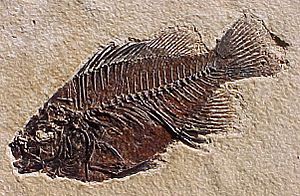Paleozoology facts for kids
Paleozoology is a cool part of biology that looks at animal fossils. It helps us learn about animals that lived a long, long time ago. Scientists who study paleozoology are called paleozoologists. They carefully study these old animal remains. This helps them figure out how animals have changed over millions of years. It's like being a detective for ancient life!
Contents
What Do Paleozoologists Study?
Paleozoologists are like time travelers. They explore the past by studying clues left behind by animals. These clues are mostly fossils. Fossils are the preserved remains or traces of ancient life.
Animal Fossils
Animal fossils can be many things. They might be bones, teeth, or shells. Sometimes, they are even footprints or burrows. These fossils are often found in rocks. They form when an animal dies and gets buried quickly. Over time, minerals replace the original parts. This turns them into stone. Each fossil tells a story about an animal that lived long ago.
Ancient Life and Evolution
By studying fossils, paleozoologists learn about ancient animals. They find out what these animals looked like. They also learn how they lived and what they ate. For example, they can discover if an animal lived on land or in the water. They can also see how animals changed over huge periods of time. This process of change is called evolution. Paleozoology helps us understand how all life on Earth is connected. It shows us how different animal groups developed.
Why is Paleozoology Important?
Paleozoology is super important for many reasons. It helps us understand our planet's history. It also teaches us about the amazing variety of life.
Understanding Earth's Past
Fossils are like pieces of a giant puzzle. They help scientists put together the history of Earth. By studying ancient animals, we can learn about past climates. We can also learn about ancient environments. For example, finding fish fossils in a desert tells us that the area was once covered by water. This helps us understand how continents and oceans have changed.
Learning About Evolution
Paleozoology gives us direct proof of evolution. When scientists find a series of fossils, they can see small changes over time. This shows how one type of animal slowly changed into another. It helps us understand how new species appear. It also explains how some species become extinct. This knowledge helps us protect animals today. It also helps us understand how life might change in the future.
Tools and Techniques
Paleozoologists use special tools and methods. They need to find, dig up, and study fossils carefully.
Finding Fossils
Finding fossils often starts in places with old rocks. These places include deserts, mountains, and riverbeds. Paleozoologists look for signs of fossils. They might spot a bone sticking out of a rock. Once they find a fossil, they mark the spot. They then plan how to dig it out safely. This process is called excavation.
Studying Fossils
After fossils are found, they are taken to a lab. Scientists clean them very carefully. They use small brushes and special tools. Sometimes, they use microscopes to see tiny details. They might also use X-rays or CT scans. These tools help them see inside the fossil without damaging it. They compare new fossils to others already known. This helps them identify the animal. It also helps them understand its place in the history of life.
Famous Discoveries
Paleozoology has led to many exciting discoveries. These discoveries have changed how we see the world.
Dinosaurs
Perhaps the most famous animals studied by paleozoologists are dinosaurs. Fossils of giant dinosaurs like Tyrannosaurus rex and Triceratops have been found all over the world. These discoveries showed us that huge reptiles once ruled the Earth. They teach us about a time long before humans existed.
Early Mammals
Paleozoologists also study early mammals. These were often small creatures that lived alongside dinosaurs. Finding their fossils helps us understand how mammals survived. It also shows how they eventually became the dominant animals after the dinosaurs disappeared. These discoveries are key to understanding our own origins.
See also
 In Spanish: Paleozoología para niños
In Spanish: Paleozoología para niños


